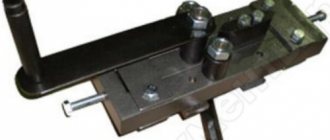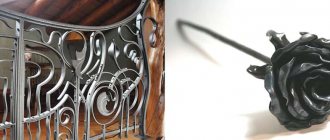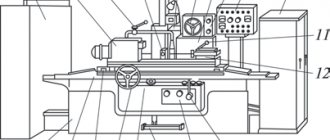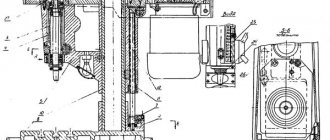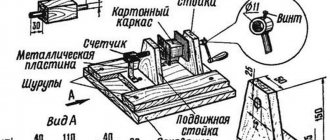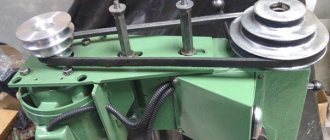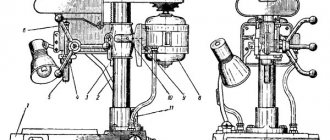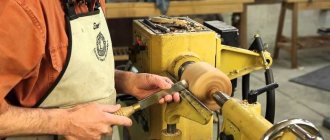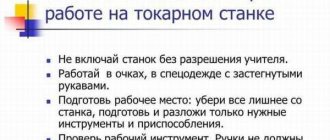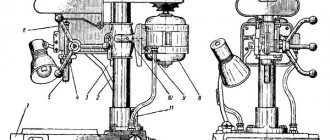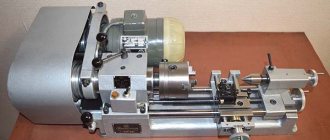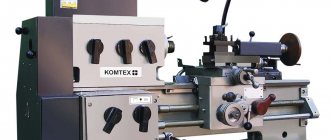Cold forging capabilities
product created by cold forging
The cold forging method involves torsion and bending of rods of a certain cross-section. The result is a set of parts from which the finished product is assembled.
Specialized Azhur machines allow you to perform the following operations:
- bending elements according to a template using the rotation method. This procedure is performed using special templates compatible with the spindle. The role of the machine is to control the accuracy of the corners;
- the rod is twisted on a machine of the same type with additional attachments included in the package;
- winding of rings is carried out on a special nozzle;
- cutting of forged parts is carried out on a special type of machine - scissor. The parts of the part are shifted relative to each other, creating an even, neat cut.
Now let’s learn more about the “Azhur” machine of each model.
Advantages of cold forging using the Azhur machine
In this way, you can easily twist and bend rods of the required cross-section. This makes it possible to make parts of a certain type and, based on them, assemble a finished product.
Capabilities of openwork universal machines today:
- Bend elements by rotation strictly according to specified parameters. Most often combined with a spindle. A modern forging and universal openwork machine is capable of controlling angular inclination with high precision.
- To twist the rod, use the same machine with additional attachment equipment.
- To screw the rings, add an additional nozzle.
- All forged parts are cut on a scissor unit. All side faces of the mechanism are made offset with respect to the rubbing surfaces. Thus, the cut is smooth and thoughtful.
Currently, “Azhur” forging machines are produced with a different model range.
Bending machine "Azhur-1M"
machine "Azhur-1M"
It can produce almost any popular elements used in artistic forging products:
- baskets;
- volutes;
- rings;
- peaks;
- reverse folds;
- endings;
- torsion bars;
- snails
The power of the machine is 3000 W, it operates from 220 or 380 V networks. “Azhur-1M” works with workpieces with a diameter of 8 to 16 mm, profile pipes No. 15 and No. 20. Torsion bars are made from 10 - 20 mm rod. The working shafts rotate at a speed of 7.5 revolutions per minute.
Additionally, the Azhur machine is equipped with:
- a power unit that drives the forging module;
- forge for heating the ends of the rod;
- forging module with a set of eccentric rollers. With its help, the ends of the rods “crow’s foot”, “faceted peak”, “dome peak” and others are formed;
- a drum for making a “ring” part with a diameter of 114 mm from a rod of round or square cross-section from 6 to 12 mm;
- snail - used to make curled elements from a profile pipe, round or square rod. Completely eliminates the appearance of creases;
- torsion bar - used to perform the element of the same name, comes in a set with washers and adapters.
The machine includes an electrical part, a mechanical part and a forge. Mechanical elements:
- electric motor;
- bed;
- forging module;
- gearbox;
- equipment
An electric motor drives the lower roller of the forging module through a gearbox. From here the movement goes to the upper and middle rollers. Eccentrics are placed on these shafts; during torsion, they bend the workpiece into the required shape. The workpiece is preheated.
Some elements are created using a drum or “snail” installed on the middle shaft. To create a “torsion bar” and “basket”, devices are installed on the upper roller. The heating forge is powered by a gas burner.
For metal bending
As a rule, the brand is Azhur M-1. It produces the following items:
- basket nets;
- ring mixers;
- bends in the opposite direction;
- volute and torsion seals.
The minimum power of the unit is at least 3000 W. Capable of operating from a 220-380 V network, while the size of the processed workpieces is 8-16 mm. The width of torsion bars is at least 15-20 mm. The speed of the working shaft is no more than eight revolutions per minute.
Additional elements for completing the Openwork unit:
- Power module for forging and drive mechanism.
- Heating forge to maintain the temperature of the rods.
- Forging module.
- A drum fairing that is capable of cutting an annular opening with a diameter of no more than 110 mm.
- The average cross-sectional size of a circle or square is 6-12 mm.
- When processing a profile pipe, a snail is made. The cross-section of the rods is made in the shape of a square and a circle.
- The torsion element is compatible with specialized washer and transition torques.
The mechanism works perfectly using electrical parts, mechanics, and the forge frame. Main functional mechanisms:
- motor on electric drive shaft;
- base of the case mechanism;
- forge promotion module;
- synchronous gear fairing;
- equipment with a mechanical element.
The gear shaft drives the base of the forging fairing. This is how the upper and lower order rollers are affected. The workpiece is bent into any shape during the movement of special eccentrics. But first, the workpiece must be heated to its melting temperature.
Rolling machine "Azhur-2"
machine "Azhur-2
The purpose of “Azhura-2” is to apply a convex ornament to a profile pipe, strip, square and round rod. The power of the electric motor is 3000 W, it operates from a three-phase network of 380 V, modification for 220 V is possible. The equipment rolls up to 4.5 linear meters per minute.
Maximum cross-sectional size of the workpiece, in mm:
- profile pipe 40 x 40;
- stripes 20 x 20;
- round bar diameter 20;
- side of the square is 20.
The shafts rotate at speeds of up to 7.5 revolutions per minute. There are two configurations of the machine: basic and complete.
The basic package includes:
- forging module;
- power unit;
- upper and lower shafts;
- gear cage with adjustment - necessary for simultaneous rotation of both shafts at any position of the upper one;
- strip guide;
- guide mechanism for square;
- rollers for rolling cuts in the shape of a square;
- rolling textured rollers;
- "Greek" ornament for stripe.
The complete package additionally includes:
- 37 types of rolling reliefs;
- 7 sets of shafts for rolling different reliefs onto a profile pipe, square;
- horizontal straightening mechanism;
- smooth adjustment of rolling speed.
The rolling machine "Azhur" consists of the following elements:
- electric motor;
- welded steel frame;
- gearbox with gears;
- forging module with a straightening mechanism;
- electrical part
The motor, through a gearbox with gears, supplies rotational motion to the shafts of the forging module. Forming rollers are located here. The rod passes between the upper and lower rollers and takes on the shape of the rollers. After which the part is fed to a straightening mechanism: two balancers, which give the part a flat or curved shape.
Rolling and bending machine "Azhur-Universal"
machine "Azhur-Universal"
This model is a combination of two previous machines “Azhur-1M” and “Azhur-2”, which allows you to create almost all known forging elements, process edges, and roll ornaments onto parts of different profiles.
The machine is offered in two configurations: basic and complete. It works with workpieces from 8 to 20 mm in diameter, strips up to 60 mm wide. The working shafts rotate at a speed of 8.5 revolutions per minute. The equipment is equipped with a 3000 W motor operating from a three-phase 380 V network. The machine is designed to work in small- and medium-scale production.
Mechanical elements of the rolling-bending device "Azhur-Universal":
- electric motor;
- bed;
- two forging modules;
- gearbox;
- electrical part
By means of a belt drive, the electric motor transmits movement to the gearbox and rollers of both forging modules. Eccentrics are located on the middle and lower rollers of the first forging module; they make parts in the shape of a “spade”, “peak”, “crow’s foot”. A “snail” is attached to the outer part of the middle roller. Using a combination of the console and the top roller, “torsion bars” are performed.
Openwork forging
Published: 03/10/2016 Metal forging is both an ancient and modern art. Over the course of many hundreds of years, our ancestors improved this process and now humanity knows enough about it to create simply unimaginable things with its help.
Once upon a time, forging was done in order to provide the army with weapons and protection, and families with necessary household items. Now all this can be produced at lower costs from other materials, or simply in a different way. Forging has almost fully reached the level of high art. This is exactly what the concept of “artistic forging openwork” refers to.
Making artistic forging is a creative process of creating magnificent and elegant objects that are designed to decorate rooms and create an indescribable atmosphere in them. What in the modern world can be forged and so majestic? Firstly, these are gates and all kinds of products in this category: fences, gates and the like. Secondly, these are canopies and signs, railings and grilles. Thirdly, these are gazebos, benches, swings, beds, tables and a huge number of similar things.
Openwork forging is a narrower part of this entire art. Openwork is a style that uses patterns with a large number of through sections separated by relatively thin bridges. It is in this manner that modern openwork forging is performed.
It is important to note that modern technology has allowed people to advance so far that forging no longer necessarily requires heating metals to high temperatures. There is a concept of cold forging, where heating is not necessary at all. In the openwork style, cold forging is carried out in the same way as in other cases. Most often, this process of changing metal shapes is resorted to so that stencils and templates can be used to produce identical parts. It is worth saying that sometimes even in this case they resort to heating the material, but only in order to smooth out the roughness at the joints or seams.
If you need cold forging in openwork style, then this will be the most affordable and fastest solution. The production process with this type of forging is much simpler than when working with hot metal. In general, it is extremely difficult to automate the forging process at high temperatures, but the invention of cold forging makes this not only feasible, but also a more profitable and simpler choice. Hand-made artistic forging, which is still often produced at extremely high temperatures, is valued much more highly both in a financial context and in the art world. Well, the well-functioning production of forged items using cold technology is a pleasant and simple way to decorate your home or office without spending large budgets on it.
Ours has its own large-scale production facilities. Artistic forging in Moscow is our main activity. We offer you a wide range of unique forged products to order and at the same time we put a piece of the master’s soul into each of them. Forged elements are manufactured on German-made welding, forging and bending machines. We use high-quality anti-corrosion and painting materials and fulfill your orders in a short time, providing graceful and unique products.
Horizontal press "Azhur-3M"
hydraulic press "Azhur-3M"
The hydraulic horizontal press "Azhur-3M" is designed for the production of metal fences, bars made of rods with a diameter of up to 20 mm, and strips with a width of up to 20 mm. Designed for use in large-scale production.
Electric motor power is 5500 W, rotation speed is 1450 rpm. Operates from a three-phase 380 V network. The press creates a force of 30 tons. It comes with equipment for making patterns: “wave”, “cartouche”, “angle”, “semicircle”, “French profile”, “eshka”, “chervonka” and others.
The press consists of the main elements:
- base;
- gear hydraulic pump in tandem;
- electromechanical hydraulic valve equipped with a safety valve;
- hydraulic tank;
- hydraulic cylinder;
- stamp with column guides;
- oil filter;
- electrical panel
Machine oil 403 and Shell Tellus 46 are used as the working fluid. The pump unit is protected from overloads by a safety valve. The press is installed on a hard surface of asphalt or concrete and adjusted horizontally according to the level.
Buy Russian
Even as a child, his grandfather, a war veteran, told Anton about the great Russian T-34 tank. Later, his father read to him about the Soviet Union's missile superiority. Perhaps this is why the young man, having received an excellent education, adequately assessed the real state of affairs in Russian science and technology. “Not everything is so bad in our native Fatherland,” Master Zakharov rightly believed. He understood that the success of his endeavor largely depended on the correct choice of equipment.
The first thing Anton found out was that European machines are expensive. And in general, if they break, then spare parts will become a real headache. Anton’s father did not allow him to buy Chinese machines, saying: “We are not so rich to buy Chinese.”
In addition, for Anton, who was brought up in a patriotic spirit and love for the Motherland, the slogan “Russia, forward” is not just words. He understood that Russia needed a strong economy.
| Reference |
| Azhur machines are designed to work with Russian rolled metal, unlike their European and Chinese counterparts. The machines have a built-in semi-automatic control system, which sharply reduces the qualification requirements for operating personnel. The most important competitive advantage is the three-year warranty period. By purchasing Azhur brand machines directly from the factory, the buyer is guaranteed protection from low-quality suppliers.t |
“If I buy a Chinese machine, I will help China, if I buy a German machine, I will help Germany, if I buy a Russian machine, I will help Russia,” thought Anton Zakharov. My father advised me not to bother too much, but, other things being equal, to focus on Russian technology.
“Especially if they are developers. Surely, they know the machines like the back of their hands, and if they break down, they will fix them with their eyes closed,” he advised Anton. Further negotiations confirmed the father was right.
First steps
So, the choice is made. Newly-minted entrepreneur Anton decided to focus on a business based on artistic forging. It was not an easy decision, but the voyage into the history of forging dotted all the i's.
It turns out that blacksmithing has absorbed all architectural eras, such as antiquity, the Gothic Middle Ages, the Romanesque style, Baroque, Rococo, Renaissance, classicism, modernism, and eclecticism. But what shocked the young man most was the art of Czech blacksmithing.
Russia was also famous for its blacksmiths from God. Just look at the Tula and Zlatoust schools. Therefore, finding a good master who would agree to train Anton was not difficult. In many former vocational technical schools, transformed into technical lyceums and colleges, blacksmith teachers of the highest category still work.
“Once upon a time, training in artistic forging began with a hammer and pipe bending mechanisms,” said Ivan Petrovich, a pensioner who took over Anton’s patronage, “now everything is different. Modern machines perform all auxiliary operations flawlessly. The blacksmith is now more of an artist than a hammerman.”
And, in fact, this is exactly so. For example, the Chelyabinsk Azhur-Universal machine is capable of producing, without the use of manual labor, a smooth “foot”, a “foot” with a double-sided pattern, a faceted “peak”, “curl” and “volute” elements, a “longitudinal twist” torsion bar, and voluminous “baskets”. ", as well as arcs and rings of various diameters. In addition, it contains a forging block for applying a variety of relief designs to the strip.
Within a week after the start of lessons, Anton was easily making a variety of window grilles, decorative barbecues, and even chairs and benches for summer cottages. The most difficult thing was learning to weld, but it went well.
| Line of machines "Azhur" |
| The line of Chelyabinsk machines consists of artistic forging machines “Azhur-1”, “Azhur-2”, “Azhur-Universal”, a horizontal-hydraulic press “Azhur-3”, a rolling-forming machine “Azhur-4”, a vertical-hydraulic press PV-100, cutting machine OS-7 and Pneumatic hammer. Experts highly appreciate the chances of the artistic forging business. To start, you will not need large initial expenses, large production areas and powerful communications. A little more than 150 thousand rubles is enough (this is the cost of the Azhur-1 machine of the basic configuration), 20-30 sq. meters of workshop and no more than 3 kW. With standard business management, the workshop will pay for itself in the first six months. |
When asked by the master whether Anton would operate the machine himself or hire a professional, Zakharov replied:
“At first I will carry out orders myself, but in the future my task is to organize a business with a team of workers of at least two dozen craftsmen, with a turnover of at least 10 million rubles a year. I will take over the management of the workshop, searching for orders, concluding large contracts, quality control, supply, etc.”
I must say that the young man approached the organization of the workshop very competently. Firstly, he rented a production facility next to a large construction organization, which immediately bombarded the guy with orders, primarily for decorative canopies over entrances, staircases and balcony railings. By the way, the machines that he purchased from the Chelyabinsk machine-building enterprise Azhurstal met the entrepreneur’s hopes. Zakharov no longer thought about the quality of artistic forging and the performance of the machines. He devoted himself entirely to finding orders and sketches at the request of clients.
Machine for twisted pipe "Azhur-4"
machine "Azhur-4"
This machine can produce twisted pipes with a diameter of 10 - 160 mm, with a given coil angle. This element greatly decorates the finished product and is used as a stand for a lantern, furniture, or fences.
The machine produces up to 4 linear meters of twisted pipe per minute. It is equipped with a 3300 W electric motor powered by a three-phase power supply. The rotation speed of the shafts is 18 revolutions per minute.
On the base there is a support plate with grooves (3 pieces) located at an angle. Sliders (3 pieces) equipped with movable brackets are attached to the base plate. On the back surface of the plate there are rulers to control movement. Each bracket is equipped with rotating plates, which rotate along their axes relative to the bracket. You can set the position of the plate using the lock.
The rotary plates are equipped with rollers on bearings and an electric motor with a gearbox. The transmission of motion is carried out through a cam-type clutch. The steady rest allows you to change cartridges for pipes of different sizes.
Pipe bending machine "Azhur-6"
machine "Azhur-6"
The three-roll machine is designed for bending profiles and rolling along a radius; it works with pipes with a diameter of up to 80 mm, strips up to 100 mm, channels no larger than No. 12, angles up to No. 63. Bending in horizontal and vertical planes is possible. The power of the electric motor is 1100 W, it operates from a three-phase power supply of 380 V. The rollers rotate at a speed of up to 11 meters per minute.
Rollers are located on three supports; a chain drive runs on them from the electric motor shaft. The pressure roller moves along the groove on the plate. The location of the slider is determined by the travel screw. The chain tension is adjusted with a screw and nut. To prevent the mechanism from becoming clogged with debris and dust, it is covered with a protective shield. During bending, the part may move and damage the plate or shield, which is why bumpers are provided.
Video with the presentation of machines for artistic forging “Azhur-1M” and “Azhur-2”:
Number and functionality of machines. Equipment options
In order for customers to come to you in a continuous stream, you should produce high-quality and original products that will have no analogues. To do this, you need appropriate equipment that provides the ability to produce a wide variety of forged elements.
We evaluated manufacturers' proposals based on the number of machines offered, their functionality, the availability of additional equipment and the ability to work with various materials:
The “Profi” series, produced in Ulyanovsk, currently has 5 machines that perform similar functions. The main specialization of this equipment is working with profile pipes. These machines have three characteristic features that distinguish them from other machines:
1). Decorative compression of the workpiece with a V or U groove on four sides 2). Possibility of applying the “Chopped Edge” texture 3). Jamming of the “Houndstooth” ending without heating
The machines in this line are also lightweight. The lightest machine, “Profi 2P,” weighs only 80 kg. The heaviest “Profi-5” weighs 210 kg. In terms of functionality, these machines differ little from each other: they make curls (volutes, monograms), baskets, and rings. It is possible to produce large rings - up to 130 mm. Longitudinal twisting is carried out (the Torsion Bar element is made), as well as jamming of the ends of the workpiece (legs) mainly from a profile pipe. Square, circle and stripe are used in a limited range of operations. Also, “Profi” does not have machines for applying a design to a workpiece, nor does it have a press. In the passports of the machines, the manufacturers stipulated that installation and maintenance of the equipment should be carried out only by the buyers themselves.
In the assortment of Chinese Blacksmith machines, we found five types of universal machines for artistic forging, a machine for artistic rolling, a hydraulic press and three pipe benders. Perhaps the manufacturer itself offers a wider selection of equipment. There are a considerable number of dealers throughout the country, but machine service is located only in Moscow and St. Petersburg. The Blacksmith series also includes metalworking machines, vices and angle gauges. The machines of this line are distinguished by the fact that they have, in addition to manual control, programmable digital control. Equipped with doors, which provides easy and convenient access to the internal components of the machine for maintenance. They have stable support legs and protection against accidental pressing of the button - a protective metal casing, a durable metal case and high operating power. The above-mentioned machines from this company operate only on mains voltage – 380V.
from Yekaterinburg, in its “Master” series, offers 7 different models for the production of forged elements, including a hydraulic press and a metal cutting machine. The machines of this series are made with the ability to connect to a 380 or 220V network. Some machines repeat the functions of each other. Almost all of the equipment in the line (except for the “Master of Twisted Pipe” and “Master-400” machines) produces balusters and performs decorative rolling of rolled metal. Curls in this series are made only by Master-2U and Master-Universal machines. The entire series of Master machines has the simplest possible layout due to the use of modern components and parts. Significant disadvantages of the equipment include a small selection of options for applying a pattern to the strip, the high cost of rollers, as well as low performance and strength properties.
In the “Azhur” series, produced by Chelyabinsk, there is a large list of machines and equipment. In total, the line includes 11 machines, most of which are produced for voltages of both 380 V and 220 V. The machines also include a rolling and forming press for pipe winding, an invoicing and cutting machine. The equipment is complemented by a wide selection of volutes, drums, rollers and rollers, which can be purchased separately. The "Azhur" series of machines has a large selection of patterns and designs for invoicing machines. The line also includes machines that have no analogues from others and “Azhur-8”. The Azhur-6 machine, unlike pipe benders from other companies, works in two planes, and the Azhur-8 produces strips. A distinctive feature of the machines in this series is their weight, because the material for their manufacture is thick, high-quality metal, which guarantees the reliability and durability of the equipment. On average, machines of the “Azhur” series last 10-12 years.
"Decor" from Chelyabinsk offers 8 machines and good equipment. A buyer of machines of this series told us that the company has not been in contact recently, which is why he was unable to purchase spare parts for the machine. Later it became known that other potential buyers had a similar problem. “Decor” machines have some similarities with “Azhur” machines, but differ in their simplified design. It also turned out that many types of equipment from “Azhur” are not suitable for “Decor” machines.
